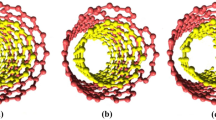Abstract
We present the study of magnetism of dimer ensemble deposited on a non-magnetic conducting substrate. The dimers consist of ions with spin 1/2 and have a random size. The magnetic ions are coupled by RKKY-interaction with random energy value. We consider two interaction models. The first assumes that dimer coupling energy has a Gaussian distribution, and the second model is based on a log-normal distribution of dimer size. The magnetization and susceptibility are evaluated from the exact solution for dimer energy and eigenstates. We show that the average exchange value and its dispersion have a strong effect on the system properties. The magnetic saturation exists under strong magnetic fields. High-temperature leads to the Curie’s law for susceptibility. The saturation magnetization of system with ferromagnetic coupling lowers, while the antiferromagnetic dimer ensemble can have non-zero magnetization under the strong magnetic field. It is determined by the dispersion of exchange energy.
GraphicAbstract






Similar content being viewed by others
Data Availability Statement
This manuscript has no associated data or the data will not be deposited. [Authors’ comment: This is a theoretical study and no experimental data has been listed.].
References
M.I. Katsnelson, VYu. Irkhin, L. Chioncel et al., Rev. Mod. Phys. 80, 315 (2008)
V.A. Ivanov, Bull. Russ. Acad. Sci. Phys. 71, 1610 (2007)
S.K.S. Patel, K. Dewangan, S.K. Srivastav et al., Curr. Appl. Phys. 14, 905 (2014)
A.A. Katanin, VYu. Irkhin, Phys. Usp. 50, 613 (2007)
K. Kindo, M. Motokawa, F.R. de Boer, High Magnetic Fields (World Scientific, Singapore, 2006), p. 125
S.F. Edwards, P.W. Anderson, J. Phys. F Metal Phys. 5, 965 (1975)
H.T. Diep, Frustrated Spin Systems (World Scientific, Singapore, 2013), p. 644
L.N. Bulaevskii, Sov. Phys. JETP 16, 685 (1963)
J.C. Bonner, H.W.J. Blöte, J.W. Bray et al., J. Appl. Phys. 50, 1810 (1979)
M. Takigawa, H. Kodama, M. Horvatic et al., J. Phys. Conf. Ser. 51, 23 (2006)
F. Lipps, A.H. Arkenbout, A. Polyakov et al., Low Temp. Phys. 43, 1298 (2018)
D. Urushihara, S. Kawaguchi, K. Fukuda et al., IUCrJ 7, 656 (2020)
A. Vasiliev, O. Volkova, E. Zvereva et al., npj Quantum Mater. 3, 18 (2018)
Y.-H. Chen, H.-S. Tao, D.-X. Yao et al., Phys. Rev. Lett. 108, 246402 (2012)
X.-L. Zhang, L.-F. Liu, W.-M. Liu, Sci. Rep. 3, 2908 (2013)
A. Friedman, J.T. Robinson, K. Perkins et al., Appl. Phys. Lett. 99, 022108 (2011)
Y. Zhou, B. Han, Zh-M Liao et al., Appl. Phys. Lett. 98, 222502 (2011)
R. Zhao, R. Jayasingha, A. Sherehiy et al., J. Phys. Chem. C 119, 20150 (2015)
R. Zhao, T. Afaneh, R. Dharmasena et al., Phys. B 490, 21 (2016)
D.A. Estyunin, I.I. Klimovskikh, VYu. Voroshnin et al., J. Exp. Theor. Phys. 125, 762 (2017)
G.A. Rudakov, K.B. Tsiberkin, R.S. Ponomarev et al., J. Magn. Magn. Mater. 472, 34 (2019)
A.V. Sosunov, K.B. Tsiberkin, V.K. Henner, Bulletin of Perm University. Physics 2, 63 (2019)
S. Saremi, Phys. Rev. B 76, 184430 (2007)
E. Kogan, Graphene 2, 8 (2012)
A.N. Rudenko, F.J. Keil, M.I. Katsnelson et al., Phys. Rev. B 88, 081405(R) (2013)
V.V. Mazurenko, A.N. Rudenko, S.A. Nikolaev et al., Phys. Rev. B 94, 214411 (2016)
D. Lee, I. Nekrashevich, H.J. Lee et al., Chem. Mater. 29, 3873 (2017)
S. Sarkar, A. Mondai, N. Giri et al., Phys. Chem. Chem. Phys. 21, 260 (2019)
V.I. Yukalov, V.K. Henner, T.S. Belozerova, Laser Phys. Lett. 13, 016001 (2016a)
V.I. Yukalov, V.K. Henner, T.S. Belozerova et al., J. Supercond. Nov. Magn. 29, 721 (2016b)
A.A. Dzhurakhalov, F.M. Peeters, Carbon 49, 3258 (2011)
J .D. Murray, Asymptotic Analysis (Springer, New York, 1984), p. 165
Acknowledgements
We are thankful the anonymous referees for the valuable comments permit to improve the initial manuscript. The research is supported by the Council for Grants of the President of the Russian Federation, contract MK-1422.2020.2.
Author information
Authors and Affiliations
Corresponding author
Ethics declarations
KT formulated the problem, realized the evaluation of eigenstates of the dimer, magnetization calculation for the system with log-normal distribution of dimer size and suppose the Laplace’s method using for the magnetization estimates. YS provided the numerical evaluation and detailed analysis of the system with normal distribution of the dimer interaction energy.
Appendix A: Laplace’s formula
Appendix A: Laplace’s formula
The Laplace’s approximation used to estimate the integrals of the form
where \(\lambda \) is a large number and S(x) has a local maximum \(x_0 \in [a, b]\). Using the Taylor series expansion near \(x_0\), one obtains
In the current paper, \(\lambda \) is a \(1 / \varDelta ^2\), S(x) is the
for the Gaussian function and
for the log-normal distribution.
Rights and permissions
About this article
Cite this article
Tsiberkin, K., Strunina, Y. Magnetism of dimer ensemble with random exchange energy. Eur. Phys. J. B 94, 21 (2021). https://doi.org/10.1140/epjb/s10051-020-00028-0
Received:
Accepted:
Published:
DOI: https://doi.org/10.1140/epjb/s10051-020-00028-0




